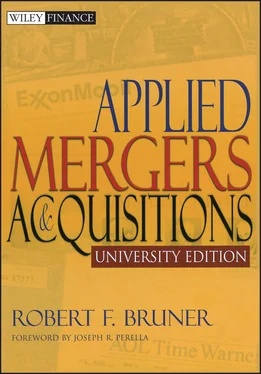7 Integration among deal design, strategy, and implementation. The process orientation in this book reinforces a central theme: the need to integrate the M&A effort across disciplines. The failure of the right hand to let the left hand know what is going on is one of the oldest administrative problems in history. Yet the revolution of business process reengineering over the past 20 years lends new urgency and sophistication to the integration message—you cannot afford to neglect the effort to integrate across M&A specialties, because, in all probability, your competitors and counterparties are doing it already. Business excellence depends on it.
“What were you thinking?” is a favorite tag line of comedians. Best practitioners use it more seriously in reference to M&A deals. The following chapters give you the frameworks, tools, and processes with which to anticipate that question and/or critique the conclusions of others. Rigorous thinking about M&A is indispensable. This book highlights new ideas, the diffusion of which will shape best practice in coming years and raise our understanding about M&A success.
1 1. The Oxford English Dictionary defines “merger” as the “consolidation or combination of one firm or trading company with another.” The French have a good word for it: fusion—this conveys the emergence of a new structure out of two old ones. An “acquisition,” on the other hand, is simply a purchase. Generally, the terms are used interchangeably. But where one is negotiating, drafting legal documents, managing tax exposure, or reporting financial results, it pays to mince words. More on this follows in later chapters.
2 2. Joseph Bain, a founder of the field of industrial organization economics, bequeathed the notion that the structure of an industry and conduct of competition within that industry drive investment returns.
3 3. How you behave can affect your position in the competitive arena.
4 4. “Newco” designates the new firm that emerges from a merger or acquisition.
CHAPTER 2 Ethics in M&A
INTRODUCTION
Ethics and economics were once tightly interwoven. The patriarch of economics, Adam Smith, was actually a scholar of moral philosophy. Though the linkage between the two fields may have worn thin in the twentieth century, they remain strong complements. 1 Morality concerns norms and teachings. Ethics concerns the process of making morally good decisions, or as Andrew Wicks writes, “Ethics has to do with pursuing—and achieving—laudable ends.” 2 The Oxford English Dictionary defines “moral” as “Of knowledge, opinions, judgments, etc.; Relating to the nature and application of the distinction between right and wrong.” 3 “Ethics,” on the other hand, is defined as “The science of morals.” 4
Ethical dilemmas pervade the field of mergers and acquisitions. For instance, consider these five cases:
1 The CEO of a firm sought to prepare the firm for sale. Part of this entailed the use of accounting policies to improve the financial track record of the firm. The practice of “prettying up” a target company for sale may be widespread—is this unethical?
2 A firm pursued an aggressive strategy of growth by acquisition that relied on creating the appearance of high growth, when in fact the companies acquired were mature and growing slowly. The appearance fueled expectations of prolonged growth, granting the firm a high share price, and therefore a strong acquisition currency with which to do more deals. Was this strategy of momentum acquiring unethical? Many companies aim to persuade investors of good growth prospects even when that growth is uncertain. Is such persuasion unethical?
3 The directors of a public corporation approved without much analysis or discussion a leveraged buyout proposal from the CEO at a relatively low price. A number of the directors were friends or affiliates of the CEO. Was the behavior of the directors unethical? Most directors develop a personal or social acquaintance with the CEOs they employ. Is this affiliation unethical?
4 A large investment bank refused to provide acquisition financing for a deal unless it was to be listed as the lead underwriter, ahead of its rival, another firm also in the underwriting syndicate. Is the use of bargaining power unethical?
5 In response to a hostile takeover attempt, a CEO considered paying “green-mail” to make the raider go away. The CEO had a strong self-interest in the outcome of the takeover attempt, as the retention of his position hinged on it. Is the payment of greenmail unethical?
The ethical dilemmas in M&A are rarely clear—or, if they are, they may entail a violation of the law. The field of business ethics offers no easy answers to dilemmas. But a failure to reflect seriously on them easily leads to unhappy outcomes. The long tradition in Western civilization says that ethical behavior promotes sustainable life; unethical behavior does not. The aim in this chapter is to sound a strong cautionary note and stimulate the M&A professional to reflect carefully on the ethical dilemmas embedded in the field.
The scant attention to ethics in books and articles on M&A is arresting, given the prevalence of ethical dilemmas in the field. One hears numerous explanations for this: We have no training in business ethics; it is embarrassing to discuss these things; we’re too busy making money; it’s a dog-eat-dog world; it’s not in my job description; and so on. If all this is true, why should we pause here at the start of a treatise on M&A to dwell on ethics? Consider these interrelated reasons.
Unethical practices are not a foundation for an enduring sustainable, enterprise. This first consideration focuses on the legacy one creates through one’s M&A deals. What legacy do you want to leave? To incorporate ethics into our M&A mind-set is to think about the kind of world that we would like to live in, and that our children will inherit.
One might object that in a totally anarchic world, unethical behavior might be the only path to life. But this only begs the point: We don’t live in such a world. Instead, our world of norms and laws ensures a corrective process against unethical behavior.
Ethical behavior builds trust; trust rewards. The branding of products seeks to create a bond between producer and consumer: a signal of purity, performance, or other attributes of quality. This bond is built by trustworthy behavior. As markets reveal, successfully branded products command a premium price. Bonds of trust tend to pay. If the field of M&A were purely a world of one-off transactions, it would seem ripe for opportunistic behavior. But in the case of repeated entry into M&A, for instance by active buyers, intermediaries, and advisers, reputation can count for a great deal in shaping the expectations of counterparties. This implicit bond, trust, or reputation can translate into more effective and economically attractive mergers and acquisitions.
The objection to this line of reasoning is that ethical behavior should be an end in itself. If you are behaving ethically only to get rich, then you are hardly committed to that behavior; being ethical for pay is inauthentic. This is true. But it is a useful encouragement to all of us that ethical behavior need not entail pure sacrifice. Some might even see this as an imperfect means by which justice expresses itself.
Ethical behavior builds teams and leadership, which underpin process excellence. This book emphasizes the importance of good process as a driver of good outcomes. Stronger teams and leaders result in more agile and creative responses to problems. Ethical behavior contributes to the strength of teams and leadership by aligning employees around shared values, and building confidence and loyalty.
Читать дальше












